经济学原理对应练习 03
- 格式:doc
- 大小:375.50 KB
- 文档页数:37
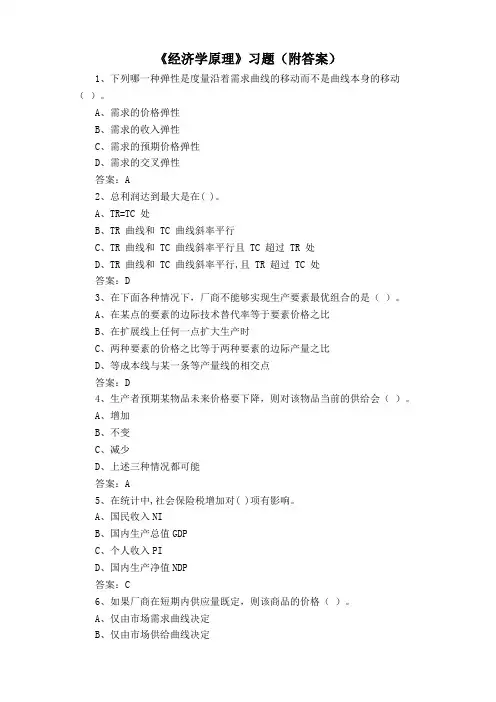
《经济学原理》习题(附答案)1、下列哪一种弹性是度量沿着需求曲线的移动而不是曲线本身的移动()。
A、需求的价格弹性B、需求的收入弹性C、需求的预期价格弹性D、需求的交叉弹性答案:A2、总利润达到最大是在( )。
A、TR=TC 处B、TR 曲线和 TC 曲线斜率平行C、TR 曲线和 TC 曲线斜率平行且 TC 超过 TR 处D、TR 曲线和 TC 曲线斜率平行,且 TR 超过 TC 处答案:D3、在下面各种情况下,厂商不能够实现生产要素最优组合的是()。
A、在某点的要素的边际技术替代率等于要素价格之比B、在扩展线上任何一点扩大生产时C、两种要素的价格之比等于两种要素的边际产量之比D、等成本线与某一条等产量线的相交点答案:D4、生产者预期某物品未来价格要下降,则对该物品当前的供给会()。
A、增加B、不变C、减少D、上述三种情况都可能答案:A5、在统计中,社会保险税增加对( )项有影响。
A、国民收入NIB、国内生产总值GDPC、个人收入PID、国内生产净值NDP答案:C6、如果厂商在短期内供应量既定,则该商品的价格()。
A、仅由市场需求曲线决定B、仅由市场供给曲线决定C、由市场需求曲线和供给曲线共同决定D、以上任一条都不能决定答案:A7、按国民收入核算体系,在一个只有家庭、企业和政府构成的三部门经济中,一定有( )。
A、家庭储蓄加折旧等于总投资加政府购买支出B、家庭储蓄加税收等于总投资加政府购买支出C、家庭储蓄等于总投资D、家庭储蓄等于净投资答案:B8、微观经济学是经济学的一个分支,主要研究()。
A、市场经济B、个体行为C、总体经济活动D、失业和通货膨胀等答案:B9、劳动(L)的总产量下降时()。
A、MPL为负B、APL是递增的C、APL为零D、MPL为零答案:A10、基数效用与序数效用的主要差别在于两种商品的( )。
A、边际替代率是否不变B、边际替代率是否递增C、效用是否可加D、边际替代率是否递减答案:C11、稀缺资源的含义是指()。
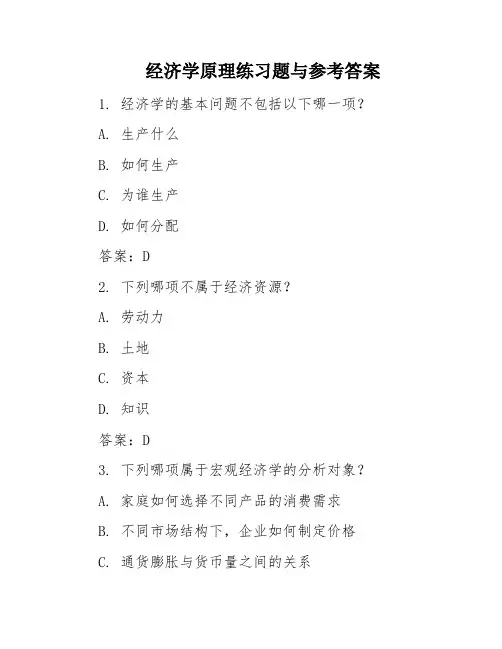
经济学原理练习题与参考答案1. 经济学的基本问题不包括以下哪一项?A. 生产什么B. 如何生产C. 为谁生产D. 如何分配答案:D2. 下列哪项不属于经济资源?A. 劳动力B. 土地C. 资本D. 知识答案:D3. 下列哪项属于宏观经济学的分析对象?A. 家庭如何选择不同产品的消费需求B. 不同市场结构下,企业如何制定价格C. 通货膨胀与货币量之间的关系D. 税收政策如何影响某种商品的市场均衡答案:C4. 机会成本是指放弃其他选择而选择当前选择的成本,以下哪项不属于机会成本?A. 选择了出国学习,放弃了在国内就业的机会B. 选择了购买一辆新车,放弃了购买一辆二手车的机会C. 选择了参加培训课程,放弃了休息的机会D. 选择了购买股票,放弃了购买债券的机会答案:C5. 下列哪项属于微观经济学的分析对象?A. 通货膨胀与货币量之间的关系B. 家庭如何选择不同产品的消费需求C. 不同市场结构下,企业如何制定价格D. 税收政策如何影响某种商品的市场均衡答案:B二、多项选择题1. 经济学的研究方法主要包括以下哪些?A. 历史分析法B. 比较分析法C. 实证分析法D. 演绎分析法答案:A、B、C、D2. 下列哪些因素会影响商品的需求量?A. 价格B. 收入C. 替代品价格D. 消费者偏好答案:A、B、C、D3. 下列哪些因素会影响商品的供给量?A. 价格B. 投入品价格C. 生产技术D. 生产者预期答案:A、B、C、D4. 下列哪些属于经济政策?A. 货币政策B. 财政政策C. 产业政策D. 消费政策答案:A、B、C5. 下列哪些属于市场经济的基本特征?A. 竞争B. 自由C. 私有D. 法治答案:A、B、C、D三、简答题1. 简述经济学的基本假设。
答案:经济学的基本假设包括:(1)理性人假设:人们在进行经济决策时,会追求自身利益最大化。
(2)完全信息假设:市场参与者拥有完全的信息。
(3)完全竞争假设:市场中存在大量买家和卖家,商品和要素可以自由流动。
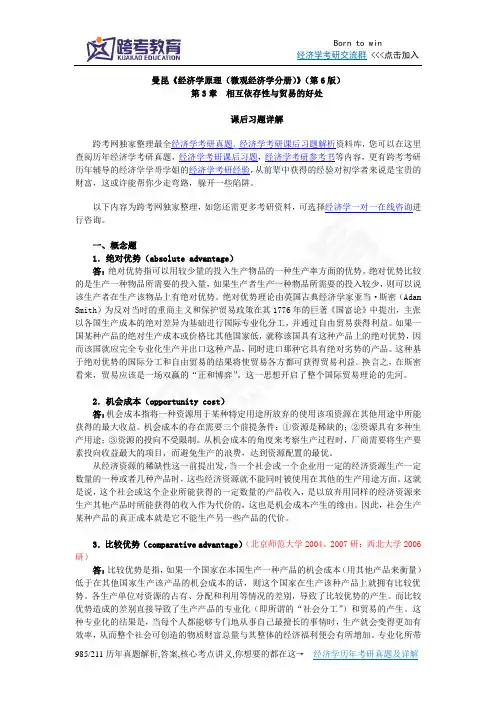
曼昆《经济学原理(微观经济学分册)》(第6版)第3章相互依存性与贸易的好处课后习题详解跨考网独家整理最全经济学考研真题,经济学考研课后习题解析资料库,您可以在这里查阅历年经济学考研真题,经济学考研课后习题,经济学考研参考书等内容,更有跨考考研历年辅导的经济学学哥学姐的经济学考研经验,从前辈中获得的经验对初学者来说是宝贵的财富,这或许能帮你少走弯路,躲开一些陷阱。
以下内容为跨考网独家整理,如您还需更多考研资料,可选择经济学一对一在线咨询进行咨询。
一、概念题1.绝对优势(absolute advantage)答:绝对优势指可以用较少量的投入生产物品的一种生产率方面的优势。
绝对优势比较的是生产一种物品所需要的投入量,如果生产者生产一种物品所需要的投入较少,则可以说该生产者在生产该物品上有绝对优势。
绝对优势理论由英国古典经济学家亚当·斯密(Adam Smith)为反对当时的重商主义和保护贸易政策在其1776年的巨著《国富论》中提出,主张以各国生产成本的绝对差异为基础进行国际专业化分工,并通过自由贸易获得利益。
如果一国某种产品的绝对生产成本或价格比其他国家低,就称该国具有这种产品上的绝对优势,因而该国就应完全专业化生产并出口这种产品,同时进口那种它具有绝对劣势的产品。
这种基于绝对优势的国际分工和自由贸易的结果将使贸易各方都可获得贸易利益。
换言之,在斯密看来,贸易应该是一场双赢的“正和博弈”。
这一思想开启了整个国际贸易理论的先河。
2.机会成本(opportunity cost)答:机会成本指将一种资源用于某种特定用途所放弃的使用该项资源在其他用途中所能获得的最大收益。
机会成本的存在需要三个前提条件:①资源是稀缺的;②资源具有多种生产用途;③资源的投向不受限制。
从机会成本的角度来考察生产过程时,厂商需要将生产要素投向收益最大的项目,而避免生产的浪费,达到资源配置的最优。
从经济资源的稀缺性这一前提出发,当一个社会或一个企业用一定的经济资源生产一定数量的一种或者几种产品时,这些经济资源就不能同时被使用在其他的生产用途方面。
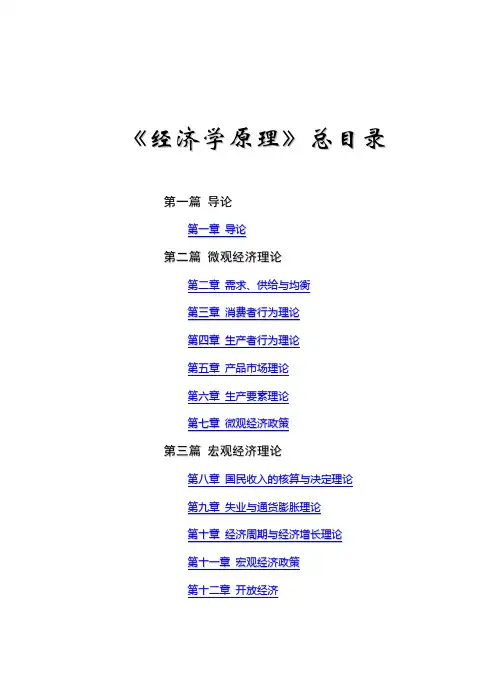
《经济学原理》总目录第一篇导论第一章导论第二篇微观经济理论第二章需求、供给与均衡第三章消费者行为理论第四章生产者行为理论第五章产品市场理论第六章生产要素理论第七章微观经济政策第三篇宏观经济理论第八章国民收入的核算与决定理论第九章失业与通货膨胀理论第十章经济周期与经济增长理论第十一章宏观经济政策第十二章开放经济第一章导论一、单项选择1、作为经济学的两个组成部分,微观经济学与宏观经济学是()A.互相对立的B.没有任何联系的C.相互补充的D.部分联系的2、古典经济学家亚当·斯密所谓的“看不见的手”是指()A.技术B.信息C.价格D.行政命令3、经济学研究的基本问题是()A.生产什么B.如何生产C.为谁生产D.以上都是4、资源的稀缺性是指()。
A.世界上的资源最终会由于人们生产更多的物品而消耗光B.相对于人们无穷的欲望而言,资源总是不足的C.生产某种物品所需资源的绝对数量很少D.由于存在资源浪费而产生的稀缺5、微观经济学解决的问题是()。
A.资源配置B.资源利用C.市场出清D.完全理性6、宏观经济学的中心理论是()。
A.失业理论B.通货膨胀理论C.国民收入决定理论D.经济增长理论7、关于实证经济学与规范经济学说法正确的是()A.两者并不是绝对相互排斥的,而应当是相互补充的。
B.规范经济学是以实证经济学为基础,而实证经济学则是以规范经济学作为指导的。
C.一般来说,越是具体的问题,实证的成分越多,而越是高层次的、决策性的问题,就越具有规范性。
D.以上说法都对二、多项选择1、微观经济学的主要内容包括()A.体格决定理论B.消费者行为理论C.生产者行为理论D.市场理论和分配理论等2、宏观经济学的基本内容有()A.宏观经济政策B.经济周期与增长理论C.国民收入决定理论D.失业与通货膨胀理论3、下列关于资源稀缺性的正确的说法有()A.资源稀缺性是相对于欲望的无限性而言的B.地球上的资源本来就少C.资源稀缺性存在于世界各地D.资源稀缺性存在于人类历史的各个时期三、判断题1、资源的稀缺性决定了资源可以得到充分的利用,不会出现资源浪费的现象。
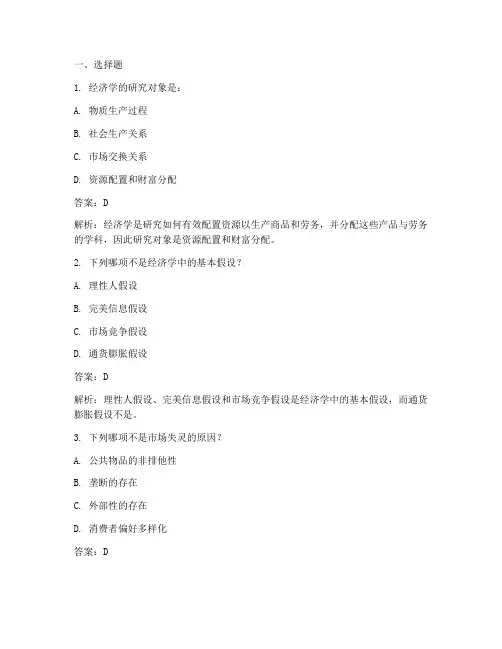
一、选择题1. 经济学的研究对象是:A. 物质生产过程B. 社会生产关系C. 市场交换关系D. 资源配置和财富分配答案:D解析:经济学是研究如何有效配置资源以生产商品和劳务,并分配这些产品与劳务的学科,因此研究对象是资源配置和财富分配。
2. 下列哪项不是经济学中的基本假设?A. 理性人假设B. 完美信息假设C. 市场竞争假设D. 通货膨胀假设答案:D解析:理性人假设、完美信息假设和市场竞争假设是经济学中的基本假设,而通货膨胀假设不是。
3. 下列哪项不是市场失灵的原因?A. 公共物品的非排他性B. 垄断的存在C. 外部性的存在D. 消费者偏好多样化答案:D解析:消费者偏好多样化是市场有效运行的条件之一,而不是市场失灵的原因。
市场失灵的原因通常包括公共物品的非排他性、垄断的存在和外部性的存在。
4. 下列哪项不是经济周期的四个阶段?A. 复苏B. 高涨C. 调整D. 繁荣答案:C解析:经济周期的四个阶段通常包括复苏、高涨、衰退和萧条,调整不是经济周期的阶段。
5. 下列哪项不是宏观调控的目标?A. 稳定物价B. 就业充分C. 经济增长D. 优化资源配置答案:D解析:宏观调控的目标包括稳定物价、就业充分和经济增长,而优化资源配置是宏观调控的手段之一,不是目标。
二、填空题1. 经济学的基本假设是__________、__________和__________。
答案:理性人假设、完美信息假设、市场竞争假设解析:经济学的基本假设包括理性人假设,即经济主体追求自身利益最大化;完美信息假设,即经济主体拥有充分的信息;市场竞争假设,即市场是充分竞争的。
2. 市场失灵的主要原因是__________、__________和__________。
答案:公共物品的非排他性、垄断的存在、外部性的存在解析:市场失灵的主要原因包括公共物品的非排他性,即一旦生产出来,无法阻止他人免费享用;垄断的存在,即市场只有一个或少数几个卖家,导致价格控制;外部性的存在,即生产或消费活动对他人产生了成本或收益,而市场没有反映这些成本或收益。
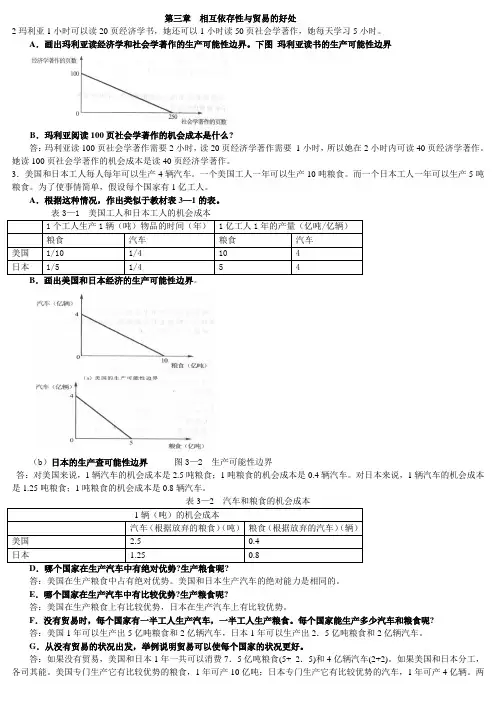
第三章相互依存性与贸易的好处2玛利亚1小时可以读20页经济学书,她还可以1小时读50页社会学著作,她每天学习5小时。
A.画出玛利亚读经济学和社会学著作的生产可能性边界。
下图玛利亚读书的生产可能性边界B.玛利亚阅读100页社会学著作的机会成本是什么?答:玛利亚读100页社会学著作需要2小时,读20页经济学著作需要1小时,所以她在2小时内可读40页经济学著作。
她读100页社会学著作的机会成本是读40页经济学著作。
3.美国和日本工人每人每年可以生产4辆汽车。
一个美国工人一年可以生产10吨粮食。
而一个日本工人一年可以生产5吨粮食。
为了使事情简单,假设每个国家有1亿工人。
A.根据这种情况,作出类似于教材表3—1的表。
表3—1 美国工人和日本工人的机会成本1个工人生产1辆(吨)物品的时间(年)1亿工人1年的产量(亿吨/亿辆)粮食汽车粮食汽车美国1/10 1/4 10 4日本1/5 1/4 5 4B.画出美国和日本经济的生产可能性边界。
(b)日本的生产查可能性边界图3—2 生产可能性边界答:对美国来说,1辆汽车的机会成本是2.5吨粮食;1吨粮食的机会成本是0.4辆汽车。
对日本来说,1辆汽车的机会成本是1.25吨粮食;1吨粮食的机会成本是0.8辆汽车。
表3—2 汽车和粮食的机会成本1辆(吨)的机会成本汽车(根据放弃的粮食)(吨)粮食(根据放弃的汽车)(辆)美国 2.5 0.4日本 1.25 0.8答:美国在生产粮食中占有绝对优势。
美国和日本生产汽车的绝对能力是相同的。
E.哪个国家在生产汽车中有比较优势?生产粮食呢?答:美国在生产粮食上有比较优势,日本在生产汽车上有比较优势。
F.没有贸易时,每个国家有一半工人生产汽车,一半工人生产粮食。
每个国家能生产多少汽车和粮食呢?答:美国1年可以生产出5亿吨粮食和2亿辆汽车,日本1年可以生产出2.5亿吨粮食和2亿辆汽车。
G.从没有贸易的状况出发,举例说明贸易可以使每个国家的状况更好。
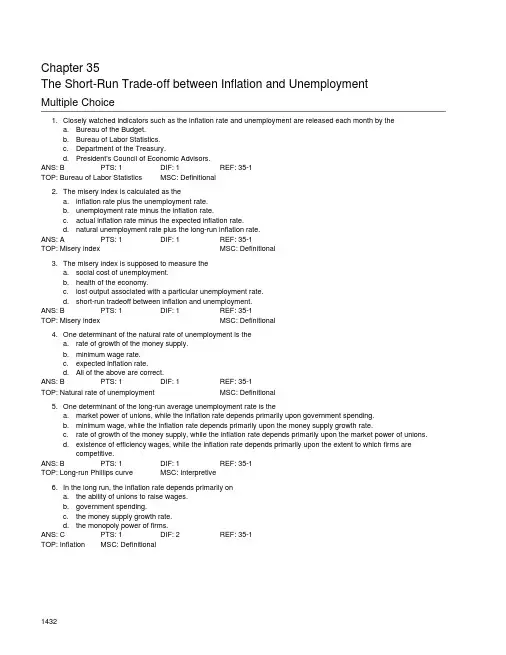
Chapter 35The Short-Run Trade-off between Inflation and UnemploymentMultiple Choice1. Closely watched indicators such as the inflation rate and unemployment are released each month by thea. Bureau of the Budget.b. Bureau of Labor Statistics.c. Department of the Treasury.d. President's Council of Economic Advisors.ANS: B PTS: 1 DIF: 1 REF: 35-1TOP: Bureau of Labor Statistics MSC: Definitional2. The misery index is calculated as thea. inflation rate plus the unemployment rate.b. unemployment rate minus the inflation rate.c. actual inflation rate minus the expected inflation rate.d. natural unemployment rate plus the long-run inflation rate.ANS: A PTS: 1 DIF: 1 REF: 35-1TOP: Misery index MSC: Definitional3. The misery index is supposed to measure thea. social cost of unemployment.b. health of the economy.c. lost output associated with a particular unemployment rate.d. short-run tradeoff between inflation and unemployment.ANS: B PTS: 1 DIF: 1 REF: 35-1TOP: Misery index MSC: Definitional4. One determinant of the natural rate of unemployment is thea. rate of growth of the money supply.b. minimum wage rate.c. expected inflation rate.d. All of the above are correct.ANS: B PTS: 1 DIF: 1 REF: 35-1TOP: Natural rate of unemployment MSC: Definitional5. One determinant of the long-run average unemployment rate is thea. market power of unions, while the inflation rate depends primarily upon government spending.b. minimum wage, while the inflation rate depends primarily upon the money supply growth rate.c. rate of growth of the money supply, while the inflation rate depends primarily upon the market power of unions.d. existence of efficiency wages, while the inflation rate depends primarily upon the extent to which firms arecompetitive.ANS: B PTS: 1 DIF: 1 REF: 35-1TOP: Long-run Phillips curve MSC: Interpretive6. In the long run, the inflation rate depends primarily ona. the ability of unions to raise wages.b. government spending.c. the money supply growth rate.d. the monopoly power of firms.ANS: C PTS: 1 DIF: 2 REF: 35-1TOP: Inflation MSC: Definitional1432。
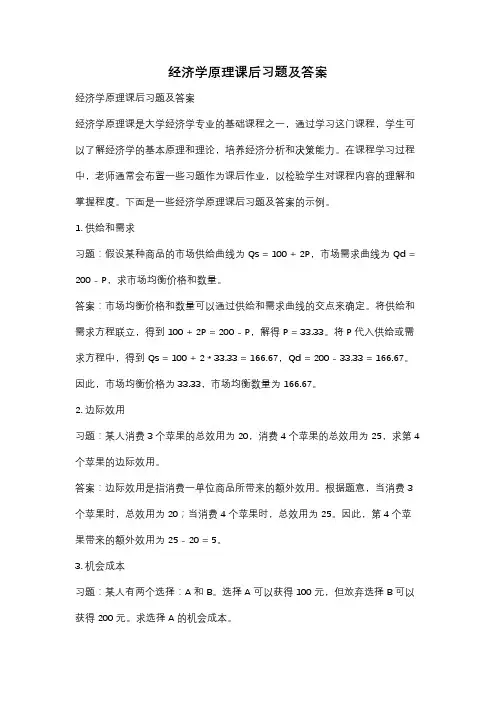
经济学原理课后习题及答案经济学原理课后习题及答案经济学原理课是大学经济学专业的基础课程之一,通过学习这门课程,学生可以了解经济学的基本原理和理论,培养经济分析和决策能力。
在课程学习过程中,老师通常会布置一些习题作为课后作业,以检验学生对课程内容的理解和掌握程度。
下面是一些经济学原理课后习题及答案的示例。
1. 供给和需求习题:假设某种商品的市场供给曲线为Qs = 100 + 2P,市场需求曲线为Qd = 200 - P,求市场均衡价格和数量。
答案:市场均衡价格和数量可以通过供给和需求曲线的交点来确定。
将供给和需求方程联立,得到100 + 2P = 200 - P,解得P = 33.33。
将P代入供给或需求方程中,得到Qs = 100 + 2 * 33.33 = 166.67,Qd = 200 - 33.33 = 166.67。
因此,市场均衡价格为33.33,市场均衡数量为166.67。
2. 边际效用习题:某人消费3个苹果的总效用为20,消费4个苹果的总效用为25,求第4个苹果的边际效用。
答案:边际效用是指消费一单位商品所带来的额外效用。
根据题意,当消费3个苹果时,总效用为20;当消费4个苹果时,总效用为25。
因此,第4个苹果带来的额外效用为25 - 20 = 5。
3. 机会成本习题:某人有两个选择:A和B。
选择A可以获得100元,但放弃选择B可以获得200元。
求选择A的机会成本。
答案:机会成本是指选择某个方案所放弃的最高价值的替代方案。
在这个例子中,选择A可以获得100元,但放弃选择B可以获得200元。
因此,选择A的机会成本为200元。
4. 生产可能性边界习题:某国家只生产两种商品:A和B。
生产一个单位的A需要消耗2个单位的劳动力,生产一个单位的B需要消耗3个单位的劳动力。
该国家有100个单位的劳动力。
画出该国家的生产可能性边界。
答案:生产可能性边界是指在资源有限的情况下,一个国家或企业所能生产的各种商品组合。
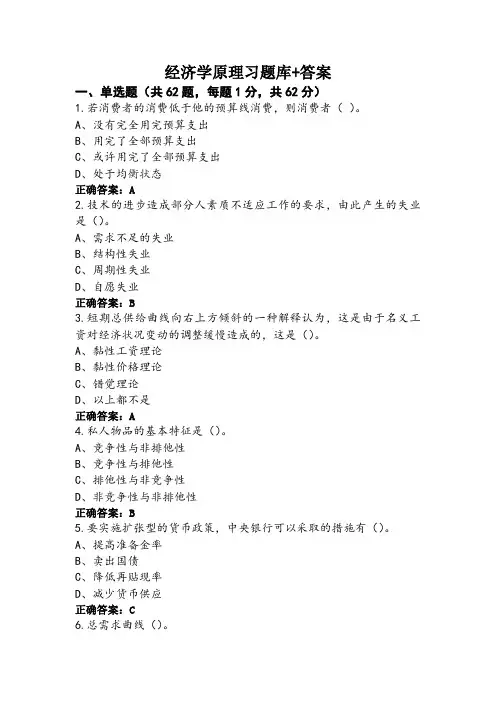
经济学原理习题库+答案一、单选题(共62题,每题1分,共62分)1.若消费者的消费低于他的预算线消费,则消费者()。
A、没有完全用完预算支出B、用完了全部预算支出C、或许用完了全部预算支出D、处于均衡状态正确答案:A2.技术的进步造成部分人素质不适应工作的要求,由此产生的失业是()。
A、需求不足的失业B、结构性失业C、周期性失业D、自愿失业正确答案:B3.短期总供给曲线向右上方倾斜的一种解释认为,这是由于名义工资对经济状况变动的调整缓慢造成的,这是()。
A、黏性工资理论B、黏性价格理论C、错觉理论D、以上都不是正确答案:A4.私人物品的基本特征是()。
A、竞争性与非排他性B、竞争性与排他性C、排他性与非竞争性D、非竞争性与非排他性正确答案:B5.要实施扩张型的货币政策,中央银行可以采取的措施有()。
A、提高准备金率B、卖出国债C、降低再贴现率D、减少货币供应正确答案:C6.总需求曲线()。
A、当其他条件不变时,政府支出减少时会右移B、当其他条件不变时,价格水平上升时会右移C、当其他条件不变时,税收减少时会左移D、当其他条件不变时,名义货币供给增加时会右移正确答案:D7.银行作为准备金持有的存款比率是()。
A、准备金率B、自行准备金C、法定准备金D、准备金正确答案:A8.同一条无差异曲线上的不同点表示()。
A、效用水平相同,但所消费的两种商品的组合比例不同B、效用水平不同,但所消费的两种商品组合比例相同C、效用水平不同,两种商品的组合比例也不相同D、效用水平相同,两种商品的组合比例也相同正确答案:A9.由于经济衰退而形成的失业属于()。
A、摩擦性失业B、结构性失业C、周期性失业D、自然失业正确答案:C10.需求曲线斜率为正的充要条件是()。
A、低档商品且收入效应超过替代效应B、收入效应超过替代效应C、低档商品D、替代效应超过收入效应正确答案:A11.供给固定不变的一般资源的服务价格叫做()。
A、租金B、经济租金C、准租金D、地租正确答案:A12.政府支出大于政府收入是()。
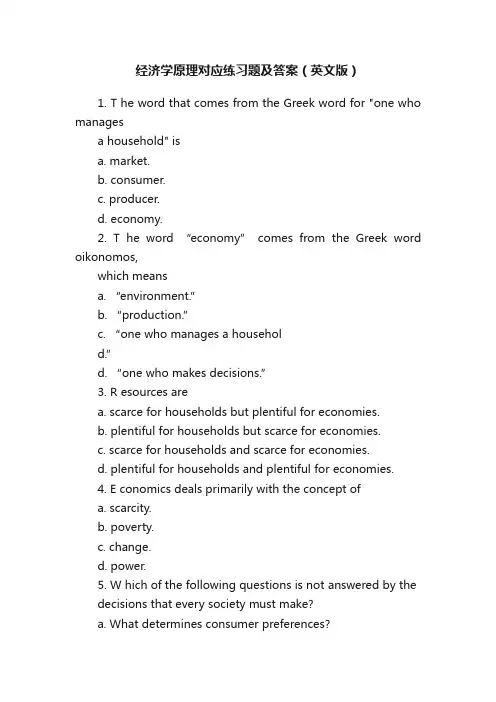
经济学原理对应练习题及答案(英文版)1. T he word that comes from the Greek word for "one who managesa household" isa. market.b. consumer.c. producer.d. economy.2. T he word “economy” comes from the Greek word oikonomos,which meansa. “environment.”b. “production.”c. “one who manages a household.”d. “one who makes decisions.”3. R esources area. scarce for households but plentiful for economies.b. plentiful for households but scarce for economies.c. scarce for households and scarce for economies.d. plentiful for households and plentiful for economies.4. E conomics deals primarily with the concept ofa. scarcity.b. poverty.c. change.d. power.5. W hich of the following questions is not answered by thedecisions that every society must make?a. What determines consumer preferences?b. What goods will be produced?c. Who will produce the goods?d. Who will consume the goods?6. T he overriding reason as to why households and societies facemany decisions is that2 Chapter 1/Ten Principles of Economicsa. resources are scarce.b. goods and services are not scarce.c. incomes fluctuate with business cycles.d. people, by nature, tend to disagree.7. T he phenomenon of scarcity stems from the fact thata. most economies’production methods are not very good.b. in most economies, wealthy people consumedisproportionate quantities of goods and services.c. governments restricts production of too many goods andservices.d. resources are limited.8. A pproximately what percentage of the world's economiesexperience scarcity?a. 25%b. 50%c. 75%d. 100%9. W hen a society cannot produce all the goods and servicespeople wish to have, it is said that the economy isexperiencinga. scarcity.b. shortages.c. inefficiencies.d. inequities.10. F or society, a good is not scarce ifa. at least one individual in society can obtain all he orshe wants of the good.b. firms are producing the good at full capacity.c. all members of society can have all they want of thegood.Chapter 1/Ten Principles of Economics 3d. those who have enough income can buy all they want ofthe good.11. W hich of the following products would be considered scarce?a. golf clubsb. Picasso paintingsc. applesd. All of the above are correct.12. E conomics is the study ofa. production methods.b. how society manages its scarce resources.c. how households decide who performs which tasks.d. the interaction of business and government.14. I n most societies, resources are allocated bya. a single central planner.b. a small number of central planners.c. those firms that use resources to provide goods andservices.d. the combined actions of millions of households andfirms.15. T he adage, "There is no such thing as a free lunch," isusedto illustrate the principle thata. goods are scarce.b. people face tradeoffs.(to get something we like, weusually have to give up another thing we like)c. income must be earned.d. households face many decisions.18. W hich of the following statements best represents theprinciple represented by the adage, "There is no such thing as a free lunch"?4 Chapter 1/Ten Principles of Economicsa. Melissa can attend the concert only if she takes hersister with her.b. Greg is hungry and homeless.c. Brian must repair the tire on his bike before he can rideit to class.d. Kendra must decide between going to Colorado or Cancunfor spring break.19. T he principle that "people face tradeoffs" applies toa. individuals.b. families.c. societies.d. All of the above are correct.20. A typical society strives to get the most it can from itsscarce resources. At the same time, the society attempts to distribute the benefits of those resources to the members of the society in a fair manner. In other words, the society facesa tradeoff betweena. guns and butter.b. efficiency and equity.c. inflation and unemployment.d. work and leisure.21. G uns and butter are used to represent the classic societaltradeoff between spending ona. durable and nondurable goods.b. imports and exports.c. national defense and consumer goods.d. law enforcement and agriculture.22. W hen society requires that firms reduce pollution, there isa. a tradeoff because of reduced incomes to the firms'owners and workers.b. a tradeoff only if some firms are forced to close.Chapter 1/Ten Principles of Economics 5c. no tradeoff, since the cost of reducing pollution fallsonly on the firms affected by the requirements.d. no tradeoff, since everyone benefits from reducedpollution.23. A tradeoff exists between a clean environment and a higherlevel of income in thata. studies show that individuals with higher levels ofincome actually pollute less than low-income individuals.b. efforts to reduce pollution typically are notcompletely successful.c. laws that reduce pollution raise costs of production andreduce incomes.d. by employing individuals to clean up pollution,employment and income both rise.24. W hich of the following phrases best captures the notion ofefficiency?a. absolute fairnessb. equal distributionc. minimum wasted. equitable outcome25. W hich of the following is true?a. Efficiency refers to the size of the economic pie;equity refers to how the pie is divided.b. Government policies usually improve upon both equityand efficiency.c. As long as the economic pie continually gets larger, noone will have to go hungry.d. Efficiency and equity can both be achieved if theeconomic pie is cut into equal pieces.26. E fficiency means that6 Chapter 1/Ten Principles of Economicsa. society is conserving resources in order to save themfor the future.b. society's goods and services are distributed equallyamong society's members.c. society's goods and services are distributed fairly,though not necessarily equally, among society's members.d. society is getting the maximum benefits from its scarceresources.27. E conomists use the word equity to describe a situation inwhicha. each member of society has the same income.b. each member of society has access to abundant quantitiesof goods and services, regardless of his or her income.c. society is getting the maximum benefits from its scarceresources.d. the benefits of society's resources are distributedfairly among society's members.28. S enator Smith wants to increase taxes on people with highincomes and use the money to help the poor. Senator Jones argues that such a tax will discourage successful people from working and will therefore make society worse off. An economist would say thata. we should agree with Senator Smith.b. we should agree with Senator Jones.c. a good decision requires that we recognize bothviewpoints.d. there are no tradeoffs between equity and efficiency.29. W hich of the following words and phrases best captures thenotion of equity?a. minimum wasteb. maximum benefitChapter 1/Ten Principles of Economics 7c. samenessd. fairnessANS: D DIF: 1 REF: 1-1TOP: Equity MSC: Definitional30. W hen government policies are enacted,a. equity can usually be enhanced without an efficiencyloss, but efficiency can never be enhanced without an equity loss.b. efficiency can usually be enhanced without an equityloss, but equity can never be enhanced without an efficiency loss.c. it is always the case that either efficiency andfairness are both enhanced, or efficiency and equity are both diminished.d. None of the above are correct.ANS: D DIF: 2 REF: 1-1TOP: Government, Efficiency, Equity MSC: Applicative31. A likely effect of government policies that redistributeincome and wealth from the wealthy to the poor is that those policiesa. enhance equity.b. reduce efficiency.c. reduce the reward for working hard.d. All of the above are correct.ANS: D DIF: 2 REF: 1-1TOP: Government, Efficiency, Equity MSC: Interpretive8 Chapter 1/Ten Principles of Economics32. W hen the government implements programs such as progressiveincome tax rates, which of the following is likely to occur?a. Equity is increased and efficiency is increased.b. Equity is increased and efficiency is decreased.c. Equity is decreased and efficiency is increased.d. Equity is decreased and efficiency is decreased. ANS: B DIF:2 REF: 1-1TOP: Government, Efficiency, Equity MSC: Interpretive33. A s a result of a successful attempt by government to cut theeconomic pie into more equal slices,a. it is easier to cut the pie, and therefore the economycan produce a larger pie.b. the government can more easily allocate the pie to thosemost in need.c. the pie gets smaller, and there will be less pie overall.d. government will spend too much time cutting and itcauses the economy to lose the ability to produce enough pie for everyone.ANS: C DIF: 3 REF: 1-1TOP: Government, Efficiency, Equity MSC: Analytical34. W hen the government attempts to improve equity in an economythe result is oftena. an increase in overall output in the economy.b. additional government revenue since overall income willincrease.c. a reduction in equity.d. a reduction in efficiency.ANS: D DIF: 2 REF: 1-1TOP: Government, Efficiency, Equity MSC: InterpretiveChapter 1/Ten Principles of Economics 935. W hen the government redistributes income from the wealthy tothe poor,a. efficiency is improved, but equity is not.b. both wealthy people and poor people benefit directly.c. people work less and produce fewer goods and services.d. wealthy people consume fewer goods, but poor people consume more goods, resulting in no real change. ANS: C DIF: 2 REF: 1-1TOP: Government, Efficiency, Equity MSC: Interpretive36. I n economics, the cost of something isa. the dollar amount of obtaining it.b. always measured in units of time given up to get it.c. what you give up to get it.d. often impossible to quantify, even in principle. ANS: C DIF: 1 REF: 1-1TOP: Opportunity cost MSC: Definitional37. W hat you give up to obtain an item is called youra. opportunity cost.b. explicit cost.c. true cost.d. direct cost.ANS: A DIF: 1 REF: 1-1TOP: Opportunity cost MSC: Definitional10 Chapter 1/Ten Principles of Economics38. T he opportunity cost of going to college isa. the total spent on food, clothing, books, transportation, tuition, lodging, and other expenses.b. the value of the best opportunity a student gives up to attend college.c. zero for students who are fortunate enough to have all of their college expenses paid by someone else.d. zero, since a college education will allow a student toearn a larger income after graduation.ANS: B DIF: 2 REF: 1-1TOP: Opportunity cost MSC: Interpretive39. M aurice receives $100 as a birthday gift. In deciding how tospend the money, he narrows his options down to four choices: Option A, Option B, Option C, and Option D. Each option costs $100. Finally he decides on Option B. The opportunity cost of this decision isa. the value to Maurice of the option he would have chosenhad Option B not been available.b. the value to Maurice of Options A, C and D combined.c. $100.d. $300.ANS: A DIF: 2 REF: 1-1TOP: Opportunity cost MSC: ApplicativeChapter 1/Ten Principles of Economics 1140. A furniture maker currently produces 100 tables per week andsells them for a profit. She is considering expanding her operation in order to make more tables. Should she expand?a. Yes, because making tables is profitable.b. No, because she may not be able to sell the additionaltables.c. It depends on the marginal cost of producing more tablesand the marginal revenue she will earn from selling more tables.d. It depends on the average cost of producing more tablesand the average revenue she will earn from selling more tables.ANS: C DIF: 2 REF: 1-1TOP: Marginal changes MSC: Applicative41. F or most students, the largest single cost of a collegeeducation isa. the wages given up to attend school.b. tuition, fees, and books.c. room and board.d. transportation, parking, and entertainment.ANS: A DIF: 2 REF: 1-1TOP: Opportunity cost MSC: Interpretive12 Chapter 1/Ten Principles of Economics42. F or a college student who wishes to calculate the true costsof going to college, the costs of room and boarda. should be counted in full, regardless of the costs ofeating and sleeping elsewhere.b. should be counted only to the extent that they are moreexpensive at college than elsewhere.c. usually exceed the opportunity cost of going to college.d. plus the cost of tuition, equals the opportunity costof going to college.ANS: B DIF: 2 REF: 1-1TOP: Opportunity cost MSC: Applicative43. F or which of the following individuals would the opportunitycost of going to college be highest?a. a promising young mathematician who will command a highsalary once she earns her college degreeb. a student with average grades who has never held a jobc. a famous, highly-paid actor who wants to take time awayfrom show business to finish college and earn a degreed. a student who is the best player on his collegebasketball team, but who lacks the skills necessary to play professional basketballANS: C DIF: 2 REF: 1-1TOP: Opportunity cost MSC: ApplicativeChapter 1/Ten Principles of Economics 1344. W hen you calculate your true costs of going to college, whatportion of your room-and-board expenses should be included?a. Your full room-and-board expenses should always beincluded.b. None of your room-and-board expenses should ever beincluded.c. You should include only the amount by which yourroom-and-board expenses exceed the income you earn while attending college.d. You should include only the amount by which yourroom-and-board expenses exceed the expenses for rent and food if you were not in college.ANS: D DIF: 2 REF: 1-1TOP: Opportunity cost MSC: Applicative45. T he opportunity cost of an item isa. the number of hours needed to earn money to buy the item.b. what you give up to get that item.c. usually less than the dollar value of the item.d. the dollar value of the item.ANS: B DIF: 1 REF: 1-1TOP: Opportunity cost MSC: Definitional14 Chapter 1/Ten Principles of Economics46. M allory decides to spend three hours working overtime ratherthan watching a video with her friends. She earns $8 an hour.Her opportunity cost of working isa. the $24 she earns working.b. the $24 minus the enjoyment she would have received fromwatching the video.c. the enjoyment she would have received had she watchedthe video.d. nothing, since she would have received less than $24 ofenjoyment from the video.ANS: C DIF: 3 REF: 1-1TOP: Opportunity cost MSC: Applicative47. R ussell spends an hour studying instead of playing tennis.The opportunity cost to him of studying isa. the improvement in his grades from studying for thehour.b. the improvement in his grades from studying minus theenjoyment of playing tennis.c. the enjoyment and exercise he would have received hadhe played tennis.d. zero. Since Russell chose to study rather than to playtennis, the value of studying must have been greater than the value of playing tennis.ANS: C DIF: 3 REF: 1-1TOP: Opportunity cost MSC: ApplicativeChapter 1/Ten Principles of Economics 1548. C ollege-age athletes who drop out of college to playprofessional sportsa. are not rational decision makers.b. are well aware that their opportunity cost of attendingcollege is very high.c. are concerned more about present circumstances thantheir future.d. underestimate the value of a college education. ANS: B DIF:2 REF: 1-1TOP: Opportunity cost MSC: Interpretive49. A rational decisionmakera. ignores marginal changes and focuses instead on “thebig picture.”b. ignores the likely effects of government policies whenhe or she makes choices.c. takes an action only if the marginal benefit of thataction exceeds the marginal cost of that action.d. takes an action only if the combined benefits of thataction and previous actions exceed the combined costs of that action and previous actions.ANS: C DIF: 2 REF: 1-1TOP: Marginal changes MSC: Interpretive50. R ational people make decisions at the margin bya. following marginal traditions.b. behaving in a random fashion.c. thinking in black-and-white terms.d. comparing marginal costs and marginal benefits. ANS: D DIF: 1 REF: 1-1TOP: Marginal changes MSC: Interpretive。
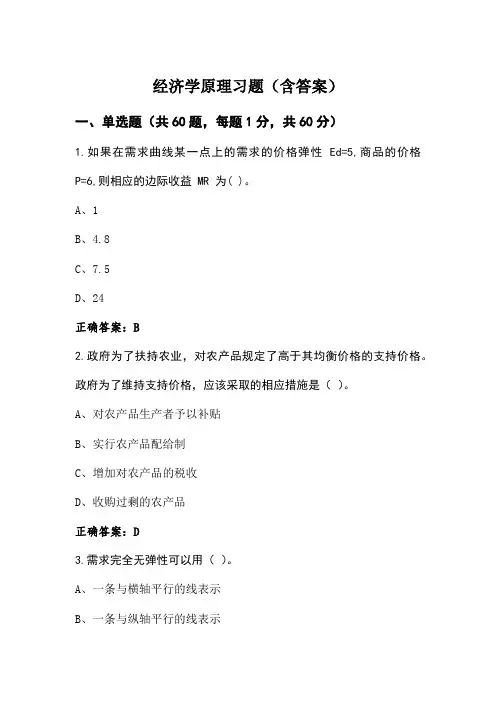
经济学原理习题(含答案)一、单选题(共60题,每题1分,共60分)1.如果在需求曲线某一点上的需求的价格弹性 Ed=5,商品的价格P=6,则相应的边际收益 MR 为( )。
A、1B、4.8C、7.5D、24正确答案:B2.政府为了扶持农业,对农产品规定了高于其均衡价格的支持价格。
政府为了维持支持价格,应该采取的相应措施是()。
A、对农产品生产者予以补贴B、实行农产品配给制C、增加对农产品的税收D、收购过剩的农产品正确答案:D3.需求完全无弹性可以用()。
A、一条与横轴平行的线表示B、一条与纵轴平行的线表示C、一条向右下方倾斜的线表示D、一条向右上方倾斜的线表示正确答案:B4.当羽毛球拍的价格下降时,对羽毛球的需求量将()。
A、不变B、视具体情况而定C、减少D、增加正确答案:D5.某月内,X 商品的替代品的价格上升和互补品的价格上升,分别引起 X 商品的需求变动量为 50 单位和 80 单位,则在它们共同作用下该月 X 商品需求数量:()。
A、减少 30 单位B、增加 130 单位C、减少 130 单位D、增加 30 单位正确答案:A6.完全竞争厂商的短期供给曲线应该是( )。
A、SMC 曲线上超过停止营业点的部分B、SMC 曲线上超过收支相抵点的部分C、SMC 曲线上的停止营业点和超过停止营业点以上的部分D、SMC 曲线上的收点相抵点和超过收支相抵点以上的部分正确答案:C7.一国的国内生产总值大于国民生产总值,说明该国公民从外国取得的收入( )外国公民从该国取得的收入。
A、大于B、等于C、小于D、可能大于也可能小于正确答案:C8.在( )情况下财政政策稳定经济的效果最佳。
A、保持财政盈余B、通货膨胀期间产生财政赤字,衰退期间发生财政盈余C、衰退期间增加政府支出减少税收,通货膨胀时减少政府支出增加税收D、保持预算平衡正确答案:C9.卡特尔制定统一价格的原则是( )。
A、使整个卡特尔中各厂商的利润最大B、使整个卡特尔的利润最大C、使整个卡特尔的成本最小D、使整个卡特尔的产量最大正确答案:B10.下列计入国民生产总值的有( )。
《经济学原理》练习题、答案(可编辑修改word版)《经济学原理》总目录第一篇导论第一章导论第二篇微观经济理论第二章需求、供给与均衡第三章消费者行为理论第四章生产者行为理论第五章产品市场理论第六章生产要素理论第七章微观经济政策第三篇宏观经济理论第八章国民收入的核算与决定理论第九章失业与通货膨胀理论第十章经济周期与经济增长理论第十一章宏观经济政策第十二章开放经济第一章导论一、单项选择1、作为经济学的两个组成部分,微观经济学与宏观经济学是()A.互相对立的B.没有任何联系的C.相互补充的D.部分联系的2、古典经济学家亚当·斯密所谓的“看不见的手”是指()A.技术B.信息C.价格D.行政命令3、经济学研究的基本问题是()A.生产什么B.如何生产C.为谁生产D.以上都是4、资源的稀缺性是指()。
A.世界上的资源最终会由于人们生产更多的物品而消耗光B.相对于人们无穷的欲望而言,资源总是不足的C.生产某种物品所需资源的绝对数量很少D.由于存在资源浪费而产生的稀缺5、微观经济学解决的问题是()。
A.资源配置B.资源利用C.市场出清D.完全理性6、宏观经济学的中心理论是()。
A.失业理论B.通货膨胀理论C.国民收入决定理论D.经济增长理论7、关于实证经济学与规范经济学说法正确的是()A.两者并不是绝对相互排斥的,而应当是相互补充的。
B.规范经济学是以实证经济学为基础,而实证经济学则是以规范经济学作为指导的。
C.一般来说,越是具体的问题,实证的成分越多,而越是高层次的、决策性的问题,就越具有规范性。
D.以上说法都对二、多项选择1、微观经济学的主要内容包括()A.体格决定理论B.消费者行为理论C.生产者行为理论D.市场理论和分配理论等2、宏观经济学的基本内容有()A.宏观经济政策B.经济周期与增长理论C.国民收入决定理论D.失业与通货膨胀理论3、下列关于资源稀缺性的正确的说法有()A.资源稀缺性是相对于欲望的无限性而言的B.地球上的资源本来就少C.资源稀缺性存在于世界各地D.资源稀缺性存在于人类历史的各个时期三、判断题1、资源的稀缺性决定了资源可以得到充分的利用,不会出现资源浪费的现象。
经济学原理练习题(含参考答案)一、单选题(共61题,每题1分,共61分)1.总供给曲线向右上方移动的原因是()。
A、需求增加B、工资提高C、技术进步D、价格提高正确答案:C2.作为经济学的两个组成部分,微观经济学与宏观经济学的关系是()。
A、各自独立的B、没有任何联系的C、相互补充的D、互相对立的正确答案:C3.需求曲线斜率为正的充要条件是()。
A、替代效应超过收入效应B、低档商品且收入效应超过替代效应C、收入效应超过替代效应D、低档商品正确答案:B4.供给与需求均衡时的价格是()。
A、均衡价格B、均衡C、均衡数量D、均衡市场正确答案:A5.()是人们可以把现在的购买力转变为未来的购买力的东西。
A、价值储藏B、交换媒介C、世界货币D、计价单位正确答案:A6.总需求曲线()。
A、当其他条件不变时,政府支出减少时会右移B、当其他条件不变时,价格水平上升时会右移C、当其他条件不变时,税收减少时会左移D、当其他条件不变时,名义货币供给增加时会右移正确答案:D7.某计算机助理工程师不满意现在某工厂的工作环境,辞职准备去一家信息技术公司找工作,这种情况的失业属于()。
A、结构性失业B、磨擦性失业C、自愿失业D、周期性失业正确答案:B8.某低档商品的价格下降,在其他情况不变时,()。
A、替代效应和收入效应相互加强导致该商品需求量增加B、替代效应和收入效应相互加强导致该商品需求量减少C、替代效应倾向于增加该商品的需求量,而收入效应倾向于减少其需求量D、替代效应倾向于减少该商品的需求量,而收入效应倾向于增加其需求量正确答案:C9.中央银行变动货币供给可通过()。
A、变动法定准备率以变动货币乘数B、变动再贴现率以变动基础货币C、公开市场业务以变动基础货币D、以上都是正确答案:B10.完全竞争条件下,厂商使用要素的边际收益是指()。
A、边际产品B、边际产品与要素价格之积C、产品价格D、边际产品价值正确答案:D11.厂商之间关系最密切的市场是()。
第三章练习题一、术语解释1、购买性支出2、转移性支出3、经常性支出4、资本性支出5、财政支出增长率6、财政支出增长弹性系数7、财政支出增长边际倾向8、瓦格纳法则二、填空1、我国依据国家职能的分别,将财政支出区分为:、、、。
2、财政支出按经济性质分为:和。
3、转移性支出主要有:、和。
4、在安排购买性支出时,政府必须遵循:。
5、按支出产生效益的时间分类:和。
6、资本支出的补偿方式:和。
7、反映财政活动规模的两个指标:占GDP(或GNP)的比重和 GDP (或GNP)的比重。
8、瓦格纳法则是由:德国经济学家提出的。
9、瓦格纳法则把导致政府支出增长的因素分为:和。
10、政府职能可以划分为两大类:和。
三、判断1、我国依据国家职能的分别,将财政支出区分为购买性支出和转移性支出。
2、购买性支出对收入分配的影响是间接地,而转移性支出对收入分配的影响是直接的。
3、购买性支出所体现的是政府的非市场性再分配活动。
4、通过转移性支出体现出的财政活动对政府形成较强的效益约束,而通过购买性支出体现出的财政活动对政府的效益约束是软的.5、在财政支出总额中,购买性支出所占的比重大些,财政活动对生产和就业的直接影响就大些,通过财政所配置的资源的规模就大些。
6、以购买性支出占较大比重的支出结构的财政活动,执行配置资源的职能较强,以转移性支出占较大比重的支出结构的财政活动,则执行收入分配的职能较强。
7、资本性支出可以全部视为当期公共物品的成本。
8、我国国民经济核算体系已由原来的平衡表体系转变为新的核算体系,财政支出分类也采用新的分类方法9、在大多数国家的大多数财政年度中,财政收入的量与财政支出的量是不相等的,通常的情况是前者大于后者。
10、财政收入反映的是财政参与GDP分配过程的活动,财政支出反映的则是财政在GDP使用过程的活动。
四、不定项选择1、下列属于消费性支出的是:()A BC D2、社会总产品的运动,从静态的价值构成上划分,可以分为哪几种。
《经济学原理》练习题(含答案)一、单选题(共60题,每题1分,共60分)1、一个人可以用一国物品和劳务交换另一国的物品和劳务的比率是( )。
A、真实GDPB、真实利率C、真实汇率D、真实变量正确答案:C2、下面哪一项活动可能引起负外部性()。
A、汽车排出废气B、修复历史建筑C、购买一台个人电脑D、在街心花园种花正确答案:A3、()是银行向另一家银行进行隔夜贷款时的利率。
A、准备金率B、贴现率C、联邦基金利率D、利率正确答案:C4、宏观经济学的中心理论是()。
A、国名收入决定理论B、价格决定理论C、工资决定理论D、汇率决定理论正确答案:A5、使平均总成本最小的产量是( )。
A、规模经济B、规模收益不变C、规模不经济D、有效规模正确答案:D6、下面不属于政府购买的项目的是()。
A、政府用财政资金建设三所中学B、政府从国外购买一批武器C、政府给公务员发放工资D、政府为低收入家庭提供住房补贴正确答案:D7、长期生产水平有时称为()。
A、长期产量B、平均产量C、一般产量D、潜在产量正确答案:D8、下列哪一项计入GDP()。
A、购买一辆用过的自行车B、购买普通股票C、汽车制造厂买进十吨钢板D、银行向某企业收取一笔贷款利息正确答案:D9、宏观经济政策的目标是()。
A、充分就业和物价稳定B、充分就业和公平C、实现充分就业、物价稳定、经济增长和国际收支平衡D、物价稳定和经济增长正确答案:D10、()是人们可以把现在的购买力转变为未来的购买力的东西。
A、计价单位B、世界货币C、价值储藏D、交换媒介正确答案:C11、厂商获得最大利润的条件是()。
A、MR>MC的差额为最大B、MR=MCC、P>AC的差额为最大D、TR>TC的差额为最大正确答案:B12、下列哪一项不是GDP的组成部分()。
A、消费B、投资C、净出口D、储蓄正确答案:D13、下列不是解释总需求曲线向右下方倾斜的一项是()。
A、财富效应B、汇率效应C、物价水平D、利率效应正确答案:C14、等成本曲线平行向外移动表明( )。
经济学原理练习试卷3(题后含答案及解析)题型有:1. 单项选择题 2. 多项选择题 3. 判断题 4. 名词解释单项选择题1.如果甲产品的价格下降引起乙产品需求曲线向左移动,那么( )。
A.甲和乙产品是替代商品B.甲和乙产品是互补商品C.甲为低档商品,乙为高档商品D.甲为高档商品,乙为低档商品正确答案:A 涉及知识点:经济学原理2.下列哪种情况使总收益下降( )。
A.价格上升,需求缺乏弹性B.价格上升,需求富有弹性C.价格下降,需求富有弹性D.价格上升,供给富有弹性正确答案:B 涉及知识点:经济学原理3.供给曲线是一条倾斜的曲线,其倾斜的方向是( )。
A.右上方B.右下方C.左下方D.左上方正确答案:A 涉及知识点:经济学原理4.在影响供给的其他因素不变时,供给量与价格呈( )变动。
A.同方向B.反方向C.一致D.不稳定正确答案:A 涉及知识点:经济学原理5.下面( )情况将导致供给的减少。
A.消费者收入的增加B.技术的变化C.成本的下降D.替代品价格的上升正确答案:D 涉及知识点:经济学原理6.下面( )会使供给曲线向右上方移动。
A.产品热销B.成本上升C.投入品价格上升D.生产环境的改善正确答案:D 涉及知识点:经济学原理7.微观经济学用( )总结了需求变动和供给变动对市场均衡的影响。
A.均衡格理论B.供求定理C.供给定理D.需求定理正确答案:B 涉及知识点:经济学原理8.在下列供给价格弹性的表述中,正确的是( )。
A.供给量变动对价格变动的反应程度B.价格变动的绝对值对需求量变动的绝对值的影响C.价格的变动量与需求变动量的比值D.需求变动量与价格的变动量的比值正确答案:A 涉及知识点:经济学原理9.关于供给弹性,下面说法不正确的是( )。
A.Es=0,它表示供给完全无弹性B.比较难生产的商品,其供给弹性一般较大C.如果产量增加只引起边际成本较大幅度的增加,则该商品的供给弹性一般较小D.商品生产周期较短的商品,供给弹性较大正确答案:B 涉及知识点:经济学原理10.当消费者的收入增加80%时,某商品的需求量增加40%。
经济学原理练习题库及答案一、单选题(共49题,每题1分,共49分)1.当美国物价水平下降引起美国利率下降时,美元在外汇市场上的真实价值下降了,这是物价水平的()。
A、财富效应B、利率效应C、汇率效应D、以上都不是正确答案:C2.某人正在等待着某项工作,这种情况可归类于()。
A、就业不足B、失业C、就业D、非劳动力正确答案:B3.下列关于自然失业率的说法哪一个是正确的()。
A、自然失业率与一国的经济效率之间关系密切B、自然失业率恒定不变C、自然失业率是历史上最低限度水平的失业率D、自然失业率包含磨擦性失业正确答案:D4.政府支出大于政府收入是()。
A、预算盈余B、预算赤字C、预算线D、预算约束线正确答案:B5.关于平均固定成本,以下表述正确的是()。
A、无论产出水平发生什么变化,它都不变B、随产量增加而增加C、曲线是U形的D、以上都不对正确答案:D6.如果投资增加150亿元,MPC为0.8,那么收入水平将增加()。
A、150亿元B、600亿元C、750亿元D、450亿元正确答案:C7.通货膨胀的含义是()。
A、一般物价水平普遍、持续的上涨B、货币发行量超过流通中的黄金量C、货币发行量超过流通中商品的价值量D、以上都不是正确答案:A8.中周期的时间大约为()。
A、5-6年B、9-10年C、3-4年D、20年左右正确答案:B9.完全竞争厂商达到短期均衡时()。
A、P>SACB、P=SACC、P<SACD、以上都有可能正确答案:D10.消费者愿意以一种物品交换另一种物品的比率是()。
A、边际收益B、边际产量C、边际成本D、边际替代率正确答案:D11.依据消费函数,引起消费增加的因素是()。
A、收入减少B、储蓄增加C、价格水平下降D、收入增加正确答案:D12.垄断厂商对同一种产品在不同的市场上(或对不同的消费群)收取不同的价格,这就是()。
A、自然垄断B、二级价格歧视C、三级价格歧视D、一级价格歧视正确答案:C13.下列选项中不是收入法核算GDP的是()。
矿产资源开发利用方案编写内容要求及审查大纲
矿产资源开发利用方案编写内容要求及《矿产资源开发利用方案》审查大纲一、概述
㈠矿区位置、隶属关系和企业性质。
如为改扩建矿山, 应说明矿山现状、
特点及存在的主要问题。
㈡编制依据
(1简述项目前期工作进展情况及与有关方面对项目的意向性协议情况。
(2 列出开发利用方案编制所依据的主要基础性资料的名称。
如经储量管理部门认定的矿区地质勘探报告、选矿试验报告、加工利用试验报告、工程地质初评资料、矿区水文资料和供水资料等。
对改、扩建矿山应有生产实际资料, 如矿山总平面现状图、矿床开拓系统图、采场现状图和主要采选设备清单等。
二、矿产品需求现状和预测
㈠该矿产在国内需求情况和市场供应情况
1、矿产品现状及加工利用趋向。
2、国内近、远期的需求量及主要销向预测。
㈡产品价格分析
1、国内矿产品价格现状。
2、矿产品价格稳定性及变化趋势。
三、矿产资源概况
㈠矿区总体概况
1、矿区总体规划情况。
2、矿区矿产资源概况。
3、该设计与矿区总体开发的关系。
㈡该设计项目的资源概况
1、矿床地质及构造特征。
2、矿床开采技术条件及水文地质条件。